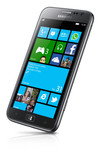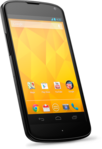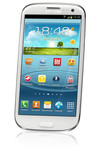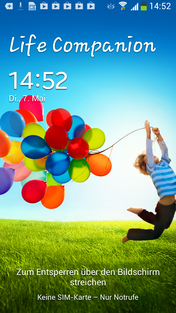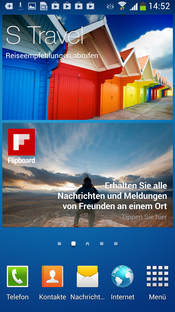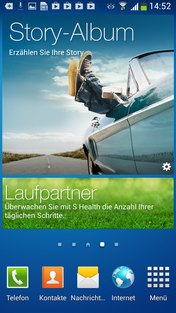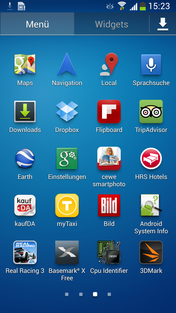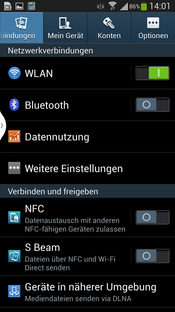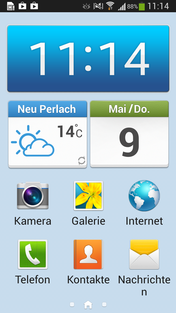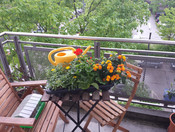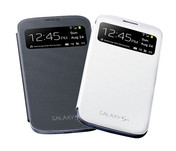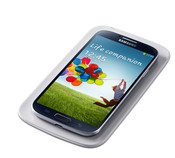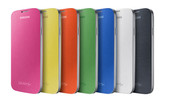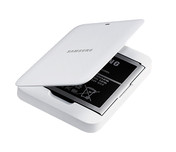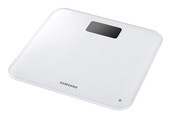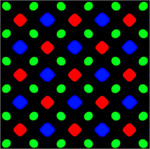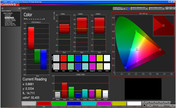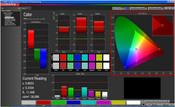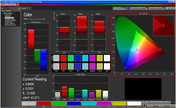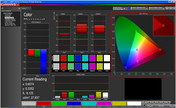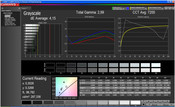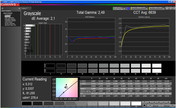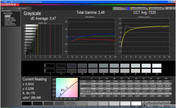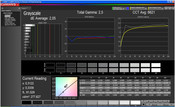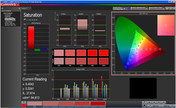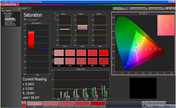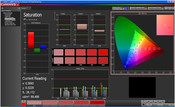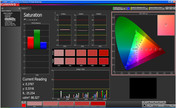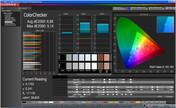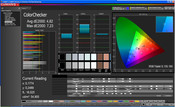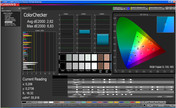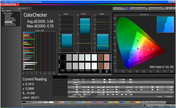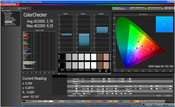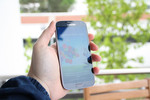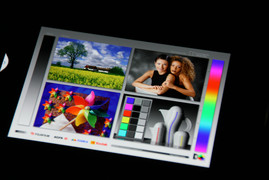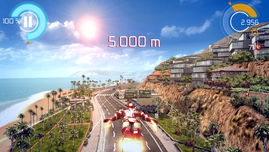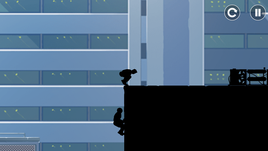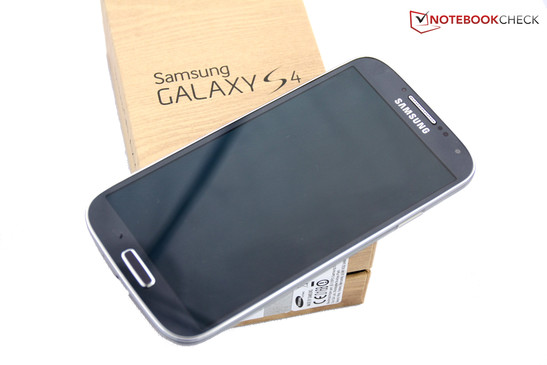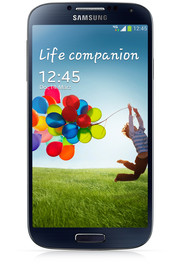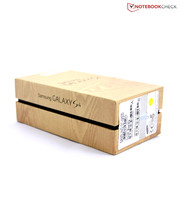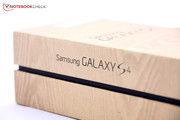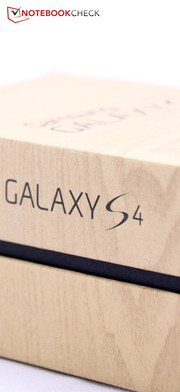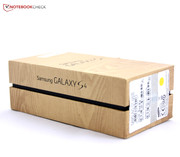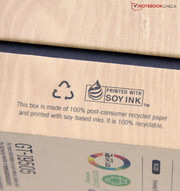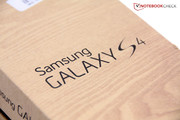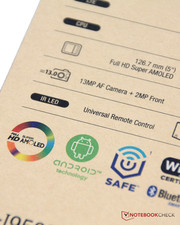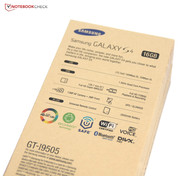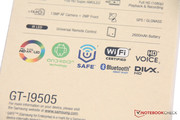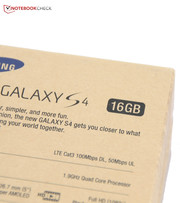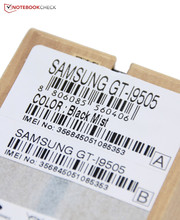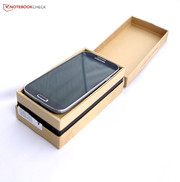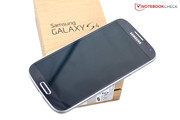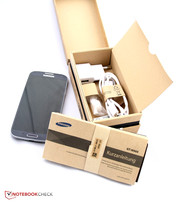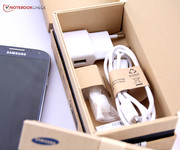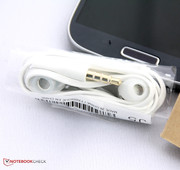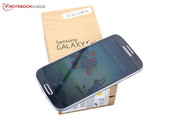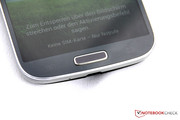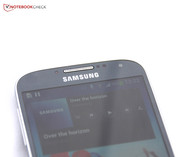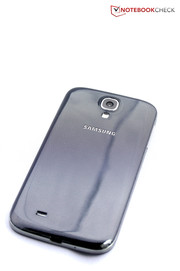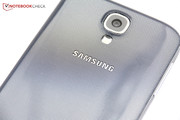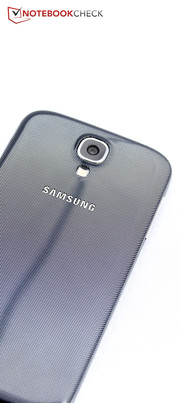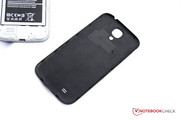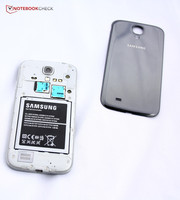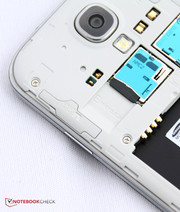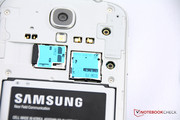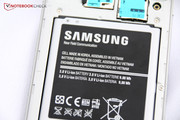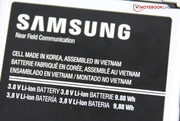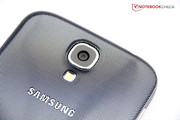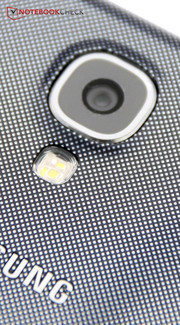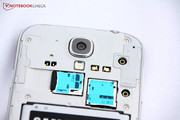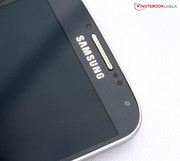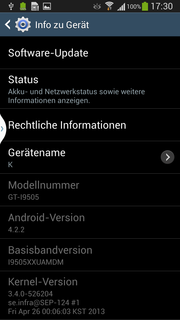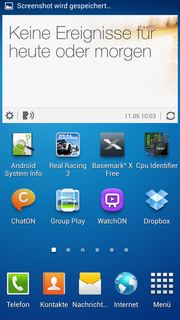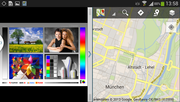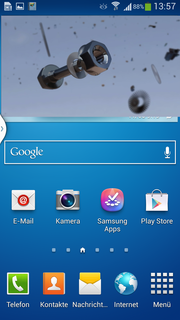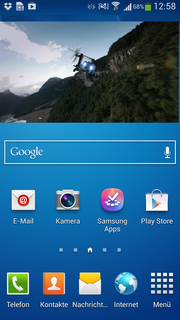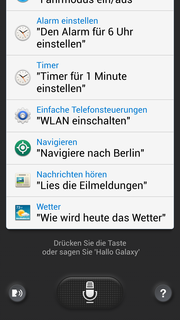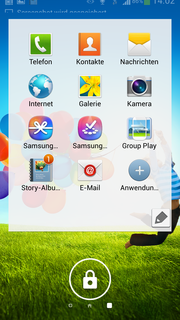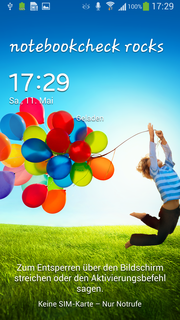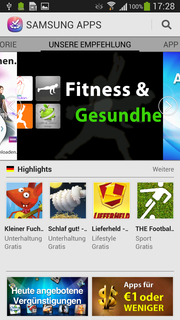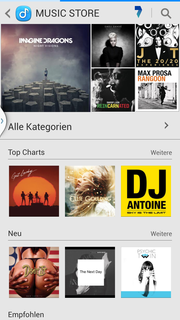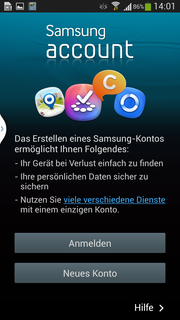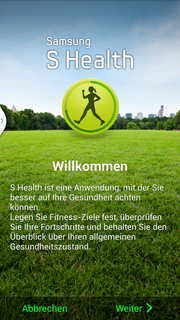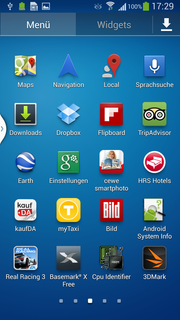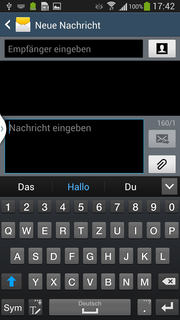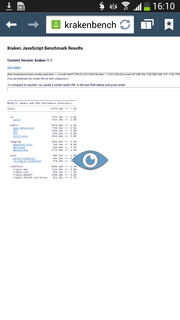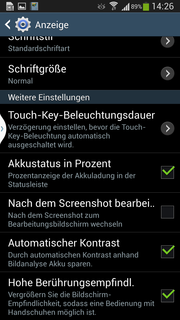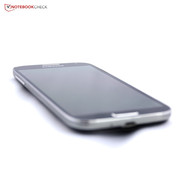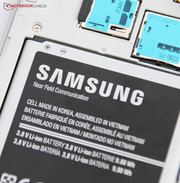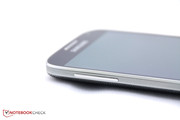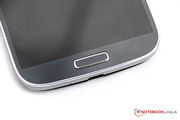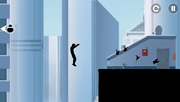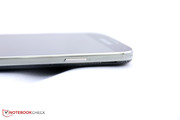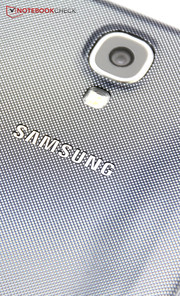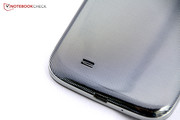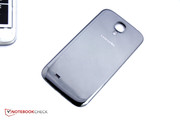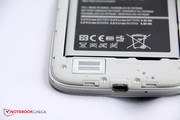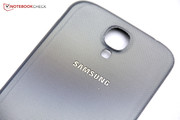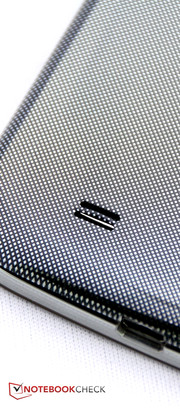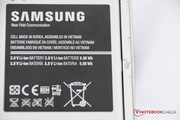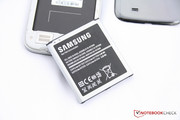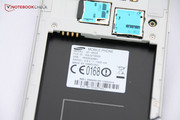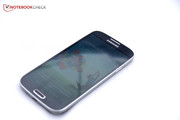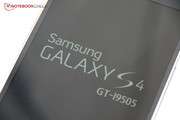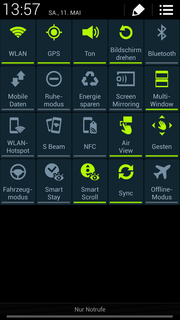Review Samsung Galaxy S4 GT-I9505 Smartphone

For the original German review, see here.
Retina display vs. Super AMOLED, industrial design vs. organic shapes, California vs. South Korea - ever since the first Galaxy S hit the shelves in 2010, the fight for the top spot in the smartphone business has been on. For the last three years, Samsung's pride has been its flagship devices, the Galaxy S, Galaxy S II and Galaxy S III, technological pinnacles within the Android ecosystem.
Now a new top model is out, the Galaxy S4. Its specifications are remarkable: A Full HD display, which makes use of the Super AMOLED technology, a Qualcomm Snapdragon 600 quad-core processor, a fast Adreno 320 graphics board, 2 GB of RAM and 16 GB of flash memory. In addition, a vast array of software novelties ranging from different display profiles (in order to generate even more brilliant imagery) to contact-free gesture controls, voice commands, eye tracking and much more have been implemented. By the middle of June, a variant with 64 GB of internal memory is supposed to be released, while Russia is rumored to be the first European country to get an octa-core variant by the end of May.
However, the competition is not sleeping, either. Apart from the eternal rival, Apple with its iPhone 5, a number of manufacturers have assembled very competitive high-quality devices as well: The HTC One has been extremely well received, not just in our review. The LG Optimus G offers great performance while being distinguished by a backside made from glass. Both the Sony Xperia Z and the Sony Xperia ZL are high-end smartphones with fast processors and Full HD displays. The Google Nexus 4 is famous for its phenomenal value-for-money-ratio. Then there is Nokia with its Windows Phone 8 flagship, the Lumia 920, a smartphone with its very own colorful design language, wireless charging functionality and nifty little details such as a touchscreen, which can be controlled with gloves as well. The HTC 8X is another Windows Phone 8 top-tier device. And then there is always Blackberry with its new Blackberry Z10 and a revamped OS fighting for a chance to get back to the top.
Some competitors stem from within Samsung, for example, the very well equipped Samsung Ativ S, a Windows Phone 8 device that has come to sell for less than 300 Euros (~$385). Last, but not least, the Samsung Galaxy S III remains on the market so that the new flagship model is condemned to offer a significant improvement in order to prevent potential customers from just choosing the more affordable predecessor. Samsung appears to have done its homework. But is this enough to keep its top spot in the market? Our detailed analysis will show.
Nothing but plastics - Samsung sticks true to the same material choice for all of its smartphones, including its high-end devices. This is not all bad, though: Next to keeping the costs down for Samsung, it also allows for more lightweight smartphones. Still, critics dismiss the haptic of such devices as inferior since they lack a first-class feel when compared to the likes of the iPhone 5 or the HTC One. Samsung tries to appease its critics (as it did with the Galaxy S III) by implementing a chrome-colored frame running around the sides. Still, the material remains what it is: Plain polycarbonate.
Whether this is to be liked or not remains a matter of taste. The same holds true for the new design choices that include numerous tiny dots on both the front and back sides of the smartphone. Our test device was a black one. Here, the dots on the rear are rather dominant due to a highly reflective surface while they appear to be less pronounced (almost like small dents) on the white version. We do not really appreciate the dominance of this effect on the backside of the Galaxy S4, particularly so since the glossy surface is not fingerprint-resistant at all. However, the rear panel can be removed completely and swapped for a different one, should this be desired. Despite the ongoing patent war between Apple and Samsung, the Galaxy S4 appears more chiseled than its predecessor, taking a step closer towards the industrial design of the iPhone 5; its curves remain more pronounced than its edges.
Talking about facts instead of taste: The Galaxy S4's build quality is excellent. Although it is crafted from plastics, the case is extremely sturdy and stable. Even when strong pressure is applied on the rear panel, no changes can be discerned on the screen itself and there are basically no clearances anywhere on the phone. The cracking of its case due to accidental drops - as it can happen with the Google Nexus 4, the LG Optimus G or the Apple iPhone 5 - is almost impossible thanks to its plastic design. In addition, the Galaxy S4 is one of the first smartphones to make use of the new Gorilla Glass 3 which is supposed to be extremely scratch-proof and next to unbreakable, as some web users have shown.
The material choice helps keep the weight down to 130 grams (~4.59 ounces), which is actually a little bit less than its predecessor which sported a screen of "just" 4.8 inches. The iPhone 5 weighs 20 grams (~0.71 ounces) less, but its 4-inch screen is considerably smaller. Thus, the Samsung Galaxy is very lightweight for its size. All of its competitors with comparably sized (often smaller) displays weigh more, especially so the Nokia Lumia 920 with a 4.5-inch display and a weight of 185 grams (~6.53 ounces).
The Apple iPhone 5 remains the thinnest one of all of the Galaxy S4 competitors, with just 7.6 millimeters (~0.30 inches). The S4 itself is almost as thin (7.9 millimeters/~0.31 inches), a feat which is only shared by the Sony Xperia Z. Most of the other devices are around 9 millimeters (~0.35 inches) thick while the Nokia’s Lumia 920 remains the most massive with 10.7 millimeters (~0.42 inches). The biggest surprise, however, is that Samsung managed to actually shrink the case of the Samsung Galaxy S4 a little bit when compared to its predecessor with its smaller screen. Samsung thus manages to fit an extraordinarily large display within a comparably compact case - which is exactly what one expects from a premium smartphone. The design - especially that of the backside - will definitely be a matter of taste, but stability and weight are top-notch.
The choice of ports taken with the Galaxy S4 shouldn't come as a surprise when compared to other smartphones: The only two physical connections to the outer world are a micro USB 2.0 port at the bottom for charging or connecting the smartphone to a PC and a 3.5mm Line In/Out port at the top. Next to the latter, a second microphone can be found for noise-canceling and stereo recording purposes. On the left, the volume rocker is situated while the standby button can be found on the right.
The micro SIM slot and the micro SD slot (for cards with up to 64 GB) are both hidden under the removable rear panel. The phone's internal storage size is 16 GB of which 9.15 GB can be accessed by the user while the rest is needed for the operating system.
Operating system
The Galaxy S4 makes use of the most up-to-date version of Google's Android operating system: Android 4.2.2 Jelly Bean brings along a number of improvements when compared to the Galaxy S III, e.g. widgets on the lock screen, a Swype-like keyboard which allows to write not only by typing but also by moving the finger from letter to letter without ever lifting it and enhanced options of content playback on other devices and screens.
The Samsung Galaxy tablets are known to support a split screen feature, which allows two apps to be displayed simultaneously. This is now also possible on the Galaxy S4. For example, one could watch a video in one part of the screen while composing an SMS in another.
Samsung chose to stick close to the basic structure of Android. However, its TouchWiz skin does still include some major changes: Its large widgets drastically change the look of Android, strengthening the optical influence of the widgets' background images, almost resembling a magazine. Despite these alterations, one can still skim to the left and to the right to access the other home screens and the start screen can still be remodeled easily. An alternative for children, the elderly or just anybody who prefers a simpler appearance might be the "easy mode" which can be accessed from the settings menu and which is meant to help people navigate their phone with more ease through the use of larger symbols and pictograms.
Options
Even stock Android is already so full of different settings that it can at times be hard not to feel overwhelmed. Samsung packs even more options into the Galaxy S4, but at least sorts these into four distinct categories, which helps with staying on top of things.
It is also possible to activate a silent mode that suppresses certain kinds of notifications during certain timeframes. One might for example want to silence all notifications about incoming calls between 12pm and 4am, with the exception of some hand-selected contacts. Then there is also a safety assistant, which can be activated by pressing both volume buttons at the same time. Apart from taking pictures with the cameras, it also informs a number of pre-selected emergency contact persons that you are in need of help.
Software
Samsung includes a number of homegrown apps, which can usually be recognized due to their "S"-prefix. "S Voice" is the name of Samsung's integrated voice recognition software, which is comparable to Apple's Siri. "ChatON" is an alternative to "What's App", "WatchON" can be used to control Smart TVs and other devices, "S Translator" marks a decent translation software and "S Health" basically boils down to your own virtual fitness trainer. "S Travel", on the other hand, was developed in cooperation with TripAdvisor and offers travel information about specifically selected or randomly chosen locations.
But this also leads us to the bad news concerning some of the software: Apparently, Samsung wants to make even more money from its customers, offering a lot of content to purchase via not one but two Samsung shops next to the Google Play Store: The "Samsung Hub" as well as "Samsung Apps". Both (as well as some preinstalled apps) require a Samsung account next to the obligatory Google account. But it gets worse: Samsung chose to install bloatware, useless promotion software, which rarely adds any value apart from providing Samsung with another income stream from its advertiseing partners by pre-installing their software.
In summary: Samsung has created a beautiful and useful Android skin, which adds many convenient enhancements and new options to the operating system. Some great apps come preinstalled, but the bloatware is extremely annoying, especially with such an expensive device.
Communication
As a high-end smartphone, the Samsung Galaxy S4 naturally supports quad band GSM and quad band UMTS as well as hexa band LTE with up to 100 MBit/s downstream and up to 50 MBit/s upstream. Thus, the device should have little trouble with many different carriers in many different countries. Reception quality was decent, even though the Galaxy S4 only showed three out of four bars when the Samsung Ativ S reported four. Speech quality and data transfer rates were still very good, though.
There have been reports about LTE problems for some carriers, but in our cellular network, no such problems arose. We neither experienced connection terminations nor did we have issues reaching full LTE speeds.
Apart from mobile phone and data connections, the Samsung Galaxy S4 supports all Wi-Fi standards - next to 802.11 b/g/n even 802.11 ac, a standard for the 5 GHz band which is still under development, but which is supposed to reach speeds of up to one Gigabit per second. Again, the reception quality is worse than with the Samsung Ativ S: Ten meters (~33 feet and two walls) away from the router, just three out of four bars remain, at times dropping down to one bar when another five meters (~16 feet) and another wall) are added. In all of these scenarios, the Ativ S showed full reception.
The settings menu reveals a number of other communication technologies built into the Galaxy S4: NFC can be used to exchange data with nearby devices, Screen Mirroring helps in sending images and videos to other screens within the same network, DLNA allows for communication with a wide variety of gadgets. In addition, the S4 supports Wi-Fi Direct and of course also Bluetooth 4.0. Tethering, turning the phone into a wireless access point to the web, is possible via USB cable, Bluetooth and Wi-Fi. All connection options that we could test worked flawlessly, although it can be hard at times to find out which technology is currently being used to transfer one's picture. For example, we accidentally sent a picture to a Smart TV instead of another smartphone. Great: By using a special cable, the smartphone can be connected via USB to HDMI-capable devices.
In addition, an infrared emitter allows - in conjunction with certain apps - the Galaxy S4 to be used as a remote control for TVs and numerous other devices. This worked exceptionally well without a long set-up procedure with a Sony Smart TV via the preinstalled "WatchON" app.
In summary: Samsung supports almost all wireless communication standards out there. It is a pity that its reception strength is reduced in comparison to other smartphones and the sheer number of implemented technologies can get confusing at times.
GPS
Samsung's smartphone is capable of both using GPS and the Russian Glonass satellite network. What is even more impressive is that the Galaxy S4 is even capable of finding enough satellites indoors in order to locate itself with an accuracy of approximately 30 meters (~98 feet). Many cheaper smartphones do not manage to do this.
Telephone functions
The telephone app does not differ from that in other Samsung smartphones. When compared to the standard Android app, it offers a different design and a number of improvements, mostly concerning the way contacts are handled: It is for example possible to define favorites in one's contacts, which can be accessed quickly via a separate button. The telephone app works reliably and is easy to use.
Cameras
No high-end smartphone is complete without a decent camera - or, better, two. The Galaxy S4 utilizes a 13-megapixel rear camera with a maximum resolution of 4128x3096 pixels resulting in a 4:3 aspect ratio. Commonly, a somewhat lower resolution of 4128x2322 pixels is chosen, matching the 16:9 aspect ratio of the screen. The sensor is manufactured by Sony; it offers an aperture of f/2.2 and a focal length of 31 millimeters. This is 5 millimeters more than the focal length of its predecessor, resulting in a slightly protruding camera. Of course, the camera system includes autofocus, an LED flash and a 4x digital zoom. The front camera is an in-house Samsung model capable of reaching a Full HD resolution of 1920x1080 pixels.
The camera of the Galaxy S4 is best suited for delivering great image quality in bright daylight, while both the HTC One and the Nokia Lumia 920 are optimized for producing great photos in low-light situations such as in bars and discos. A direct comparison with our reference DSLR camera reveals a noticeable blue tint within Samsung's pictures. The resulting photos are a little bit over-sharpened with some weak fringing in the corners. Still, these are just details. Overall, this is one of the best smartphone cameras, actually taking pictures with a higher resolution than our digital single lens reflex camera while offering tons of options. The 2-megapixel front camera, on the other hand, yields somewhat grainy and lifeless photos, but its image quality is more than sufficient for its main application, video calls.
Camera app and settings
Users of a Samsung Galaxy Camera will immediately feel at home in the Galaxy S4's camera app. At the top of the screen, all of the most important settings can be found. On the right, the trigger and the mode-changing button is located while all the effects (including live preview functionality) are situated below. All of this can be used quickly and intuitively while still opening up numerous possibilities: Samsung offers twelve different imaging modes, allowing the user to cut some part out of the picture for example, or put himself in there as well with the help of the front camera. In addition to dozens of effects (like vignettes or a cartoon feel), there are also continuous shooting modes, HDR images, panorama features, animated GIFs, photos which include a short sound file and more.
Speech quality
It is easy to forget that the Samsung Galaxy S4 can also be used as just a mobile phone. Speech quality is very good: The person at the other end of the line can hear everything very clearly and without any disruptions. Sound on our end was a little bit duller, but this may have been due to the caller's landline phone. The phone's maximum volume is more than sufficient as well - unless one is using the speakers. It would not have hurt for them to be a bit louder.
Accessories
As should be expected from every high-end smartphone, the Galaxy S4 ships at least with a power adapter, a micro USB cable and a quick start guide. This is not much, but there are a large variety of things that can be bought separately.
The S-View Cover (~29 Euros/~$37) reminds us of the good old times when flip phones with two screens prevailed. The smartphone recognizes whether the cover is closed or open, displaying all-important information within a small viewing window in the S-View Cover. Once the cover is opened, the usual lock screen appears. Samsung also offers a special cover for inductive (wireless) charging, quite like the Nokia Lumia 920. Cover and charging station together cost around 79 Euros (~101). The more traditional Flip Cover and Cover+ (each ~19 Euros/~$24) are available in many vibrant colors, and there is also a separate charging station with another spare battery for 39 Euros (~$50).
Two unusual accessories: Samsung also sells a heart frequency monitor (~79 Euros/~$101) and a personal scale (~69 Euros/~$89) which can be connected to the smartphone, resulting - in combination with the S Health app - in a virtual personal fitness trainer.
Warranty
As always, Samsung offers 24 months of warranty based on a bring-in service so that the device has to be sent to a Samsung service partner. There are no warranty extension programs for Samsung smartphones.
Input Devices & Operation
Touchscreen
The 5-inch capacitive touchscreen of the Galaxy S4 recognizes up to 10 fingers simultaneously. There have been no input issues at all during our test, even multi-touch gestures like two-finger pinch-to-zoom worked reliably. More so, it was actually fun due to the extremely responsive system leading to very fluent scrolling and zooming thanks to the Galaxy S4's high system performance. Samsung even includes two new gestures: Sweeping over the screen with the side of the hand creates a screenshot, while covering the phone with the entire hand stops all media playback.
Touchscreen sensitivity can be increased in the system settings so that it can even be used with gloves on, a feature Samsung borrowed from the Nokia Lumia 920. However, while it worked well for the Nokia device, the Galaxy S4 takes its time. It is usually best to start by touching the screen with a bare finger in order to let it know that it is going to be needed soon. Afterwards, thin gloves work rather well - still, thick winter gloves are not going to register with the device.
Software keyboard
Samsung has expanded its virtual keyboard. The most striking difference to earlier iterations: A new row just reserved for the numbers. This comes in extremely handy since it eliminates the need to switch between the letter and the number mode, but the keyboard also grows slightly in height. This is not too much of a problem due to the Galaxy S4's large display, especially considering that the keys themselves are not as large in height as those of Android's stock keyboard. Luckily, we were still able to type without missing the keys during actual usage, but it is of course always possible to replace Samsung's keyboard by the stock keyboard or to download another one from the Google Play Store.
The keyboard offers a vast number of settings, ranging from the traditional T-9 layout to voice dictation and handwriting recognition. The latter works surprisingly well, although whole words seem to be recognized more easily than single letters. The touchscreen can only be used with one's fingers though, not with a touchpen. Voice dictation works reliably as well, most words are identified correctly even when we talked fast or mumbled.
Voice control
Speech can be used to control many other services of the Galaxy S4. The standard "Hello Galaxy" command unlocks the smartphone if no security code is used, directly opening the voice command software "S Voice". Incoming calls can be accepted or rejected via voice commands. It is also possible to deactivate alarm clocks, change the wake-up time or to activate the camera trigger (which is actually quite nice as it eliminates the danger of blurring the image by pressing the camera button). All of this works astonishingly well in quiet surroundings - the main problem is to remember that these voice commands can be used!
Eye control
The eye recognition software is capable of tracking your eye movements, keeping the screen active as long as you look at it. In addition, the Galaxy S4 can scroll on web pages or in documents according to where you look. Last, but not least, videos are paused when you stop glancing at the screen.
Scrolling worked rather well in our test, although it has to be taken into account that the smartphone should not be tilted as this changes the viewing angle, causing the system to react by scrolling accordingly. Once one has grown accustomed to this effect, it is actually possible to use it to simply scroll by tilting the smartphone while looking at it. The video playback feature was another thing: Sometimes, we did not manage to force the Galaxy S4 to pause the video just by looking elsewhere. Only after it had actually recognized our eyes, did it work, in fact overshooting in the process: Sometimes, we just glanced sideways for a short moment, causing the video to pause before finally continuing, but only after a short delay.
Other input methods
Samsung has even more to offer when it comes to controlling your smartphone: You could for example set it to show missed calls or automatically call a previously selected contact once it is lifted up. In addition, by simply hovering with your finger a few millimeters above the screen, additional "mouse over" information about objects can be shown in certain apps, which are optimized for this feature.
In contrast to the screen of the Galaxy S III with its 1280x720 pixels, the new generation offers a Full HD Super AMOLED display with 1920x1080 pixels - a better-than-retina pixel density of 441 pixels per inch (the iPhone 5 sports "merely" 326 pixels per inch). Of course, on a 5-inch display the human eye cannot really make out the difference between these densities any more.
Due to the organic nature of the LEDs, there are some differences in the efficiency of the three basic colors blue, red and green from which the screen is assembled. In order to compensate for this effect, Samsung has chosen different sizes for the green, blue and red dots while arranging them in a pattern of diamonds (blue and red) and ovals (green) - something Samsung calls "Diamond Pixels".
Samsung's OLED displays tend to fall behind in terms of brightness when compared to its LCD competitors. This does not change with the Galaxy S4: Its average brightness of 300.6 cd/m² is still less than what most LCD displays offer.
| |||||||||||||||||||||||||
Brightness Distribution: 95 %
Center on Battery: 296 cd/m²
Contrast: ∞:1 (Black: 0 cd/m²)
ΔE Greyscale Calman: 3.47 | ∀{0.09-98 Ø5}
Gamma: 2.46
CCT: 7220 K
Subjectively, image rendition is not only extremely colorful, but also extremely sharp due to the high resolution and pixel density of the Galaxy S4. Its contrast and its deep black levels are extraordinary, with a contrast ratio of 2478:1 and great black levels of 0.119 cd/m². None of its competitors can compete with these values.
Samsung offers four distinct display modes, as is known from TVs: Contrast and color saturation are changed in a manner that allows them to fit the screen content - or simply the user's taste. Alternatively, one can choose to let the system decide instead. The four modes are:
· Dynamic: Very high color saturation
· Standard: Normal saturation and contrast
· Professional Photo: Color reproduction as natural as possible
· Video: Decreased color saturation
We are examining the screen in all four modes using the CalMAN software and a colorimeter. The resulting screenshots can be found below.
The "dynamic" mode tends to overemphasize all colors; "video" comes closest to the objective ideal, including its grayscale rendering. In the "dynamic" mode, on the other hand, grays tend to come with a (barely) noticeable greenish tint. Still, grayscale reproduction works rather well, remaining almost lifelike in all modes on the Galaxy S4.
Since even today, some scenes in Hollywood movies are taken with a smartphone camera - which only get better over time - it may be useful for professionals to see how professional material taken in the sRGB color space or even Adobe's RGB color space is rendered on the screen. The "professional photo" mode is actually called AdobeRGB in some countries, emphasizing Samsung's claim that the Galaxy S4 is capable of covering the Adobe RGB color space (which is much larger than the sRGB color space). We are putting this statement to the test using the color checker of the CalMAN software. And indeed, with an average Delta E of just 2.78, the Galaxy S4 seems to be well suited for Adobe RGB while the sRGB color deviations were considerably larger.
So, which color mode should you choose? If you prefer strong colors, "dynamic" might be a good choice, especially since it fits the colorful interface Samsung has decided to implement in the Galaxy S4. The most natural color reproduction can be reached with the "video" mode while the other two come to lie somewhere in between. It might be best to just try out all the different options in order to decide which one to choose.
Even outdoors, you will be happy with your Galaxy S4, at least on cloudy days: The boosted maximum brightness (in comparison to its predecessor) and its extraordinary contrast levels make it usable if the display brightness is turned way up. It takes direct sunlight to really bring the Galaxy S4 to its knees, making it strenuous to decipher the screen. Luckily, the display is not as reflective as we feared, so that the Samsung Galaxy S4 ends up being usable outdoors.
Of course, a high-end smartphone has to deliver high-end performance. Thus, the Galaxy S4 ships with the proven SoC Qualcomm Snapdragon 600. The same quad-core CPU is used in the HTC One as well, but clocked at 1.7 GHz instead of Samsung's 1.9 GHz. The GPU is an Adreno 320 with two cores and a clock speed of 450 GHz, accompanied by 2 GB of RAM and 16 GB of flash memory. An octa-core Galaxy S4 has been announced, but no availability date for Europe has been released yet.
However, the quad-core processor within the Snapdragon 600 SoC is already more than sufficient to catapult the Galaxy S4 to the top spot of nearly all of our CPU and system performance smartphone ratings. The difference to its predecessor, the Galaxy S III, is tremendous: At least 34% and up to 82%. This helps to further corroborate the impression that both the operating system as well as all apps are running extremely smoothly, staying responsive at all times.
| AnTuTu v3 - Total Score (sort by value) | |
| Samsung Galaxy S4 GT-I9505 | |
| Samsung Galaxy S3 | |
| HTC One | |
| Sony Xperia Z | |
| Sony Xperia ZL | |
| LG Optimus G E975 | |
| Google Nexus 4 | |
| HTC One X+ | |
| Geekbench 2 - 32 Bit - Total Score (sort by value) | |
| Samsung Galaxy S4 GT-I9505 | |
| Apple iPhone 5 | |
| Samsung Galaxy S3 | |
| HTC One | |
| Sony Xperia Z | |
| Sony Xperia ZL | |
| LG Optimus G E975 | |
| Google Nexus 4 | |
| BlackBerry Z10 | |
| HTC One X+ | |
| Smartbench 2012 - Productivity Index (sort by value) | |
| Samsung Galaxy S4 GT-I9505 | |
| Samsung Galaxy S3 | |
| HTC One | |
| Sony Xperia Z | |
| Sony Xperia ZL | |
| LG Optimus G E975 | |
| Google Nexus 4 | |
| HTC One X+ | |
The Adreno 320 GPU with its two cores clocked at 450 MHz is responsible for the phenomenal 3D performance of the Samsung Galaxy S4. Again, it takes the top spot, beating the Galaxy S III by up to 73%. Only the Google Nexus 4 (or the structurally identical LG Optimus G) is at times able to keep the pace of the Galaxy S4.
| Basemark ES 2.0 - Taiji Free (sort by value) | |
| Samsung Galaxy S4 GT-I9505 | |
| Samsung Galaxy S3 | |
| HTC One | |
| Sony Xperia Z | |
| Sony Xperia ZL | |
| LG Optimus G E975 | |
| Google Nexus 4 | |
| HTC One X+ | |
| NenaMark2 - --- (sort by value) | |
| Samsung Galaxy S4 GT-I9505 | |
| Samsung Galaxy S3 | |
| HTC One | |
| Sony Xperia Z | |
| Sony Xperia ZL | |
| LG Optimus G E975 | |
| Google Nexus 4 | |
| HTC One X+ | |
| GFXBench (DX / GLBenchmark) 2.7 | |
| T-Rex Onscreen (sort by value) | |
| Samsung Galaxy S4 GT-I9505 | |
| Apple iPhone 5 | |
| Samsung Galaxy S3 | |
| Sony Xperia Z | |
| Sony Xperia ZL | |
| Nokia Lumia 920 | |
| LG Optimus G E975 | |
| Google Nexus 4 | |
| 1920x1080 T-Rex Offscreen (sort by value) | |
| Samsung Galaxy S4 GT-I9505 | |
| Apple iPhone 5 | |
| Samsung Galaxy S3 | |
| Sony Xperia Z | |
| Sony Xperia ZL | |
| Nokia Lumia 920 | |
| LG Optimus G E975 | |
| Google Nexus 4 | |
| GLBenchmark 2.5 | |
| Egypt HD Fixed Time (sort by value) | |
| Samsung Galaxy S4 GT-I9505 | |
| Apple iPhone 5 | |
| Samsung Galaxy S3 | |
| HTC One | |
| Sony Xperia ZL | |
| LG Optimus G E975 | |
| Google Nexus 4 | |
| HTC One X+ | |
| 1920x1080 Egypt HD Offscreen Fixed Time (sort by value) | |
| Samsung Galaxy S4 GT-I9505 | |
| Apple iPhone 5 | |
| Samsung Galaxy S3 | |
| HTC One | |
| Sony Xperia ZL | |
| LG Optimus G E975 | |
| Google Nexus 4 | |
| HTC One X+ | |
| 3DMark | |
| 1280x720 Ice Storm Standard Score (sort by value) | |
| Samsung Galaxy S4 GT-I9505 | |
| Apple iPhone 5 | |
| HTC One | |
| Sony Xperia ZL | |
| LG Optimus G E975 | |
| Google Nexus 4 | |
| 1280x720 Ice Storm Standard Graphics (sort by value) | |
| Samsung Galaxy S4 GT-I9505 | |
| HTC One | |
| Sony Xperia ZL | |
| LG Optimus G E975 | |
| Google Nexus 4 | |
| 1280x720 Ice Storm Standard Physics (sort by value) | |
| Samsung Galaxy S4 GT-I9505 | |
| HTC One | |
| Sony Xperia ZL | |
| LG Optimus G E975 | |
| Google Nexus 4 | |
With the exception of the Peacekeeper benchmark, the Galaxy S4 delivers the best results of all smartphones in all browser benchmarks. Again, during actual use, browsing felt fast and delay-free.
| Peacekeeper - --- (sort by value) | |
| Samsung Galaxy S4 GT-I9505 | |
| Apple iPhone 5 | |
| Samsung Galaxy S3 | |
| HTC One | |
| Sony Xperia Z | |
| Sony Xperia ZL | |
| Samsung ATIV S | |
| LG Optimus G E975 | |
| Google Nexus 4 | |
| BlackBerry Z10 | |
| HTC One X+ | |
* ... smaller is better
Samsung's engineers seem to have thought about every detail, because even the flash memory offers better data transfer rates and access times than all of its competitors. This helps the system and its apps to start faster and without unnecessary lag.
The overall performance of the Samsung Galaxy S4 is nothing but impressive: The device is faster than all its competitors are - by far. Even the super-fast, fabled HTC One falls behind in almost all benchmarks.
Games
The dual-core Adreno 320 graphics card clocked at 450 MHz is also used in the Sony Xperia Z, the Sony Xperia ZL, the HTC One and the LG Optimus G. It has proven time and again that it offers more than enough power for even the most demanding games out there (including those to be released in the foreseeable future).
No matter whether its casual games such as "Angry Birds: Star Wars", demanding 3D games like "Real Racing 3" or "Iron Man 3", fast Jump'n'Run games such as "Vector" or action games such as "Zombiewood", we never experienced any stuttering at all. Of course, both the fast flash memory and the powerful CPU contribute to this result.
Input via the position sensor and the touchscreen was very responsive and precise, as seen in "Iron Man 3", where both elements are combined. The same impression holds true for the other games as well: Precision was always top-notch.
Temperature
All this raw power squeezed inside the Galaxy S4 has to produce a lot of waste heat. Luckily, Samsung's engineers have managed to keep the Galaxy S4 cooler than the Galaxy S III. Despite all performance improvements, we never measured more than 42.5 degrees Celsius (108.5 degrees Fahrenheit), a value only achieved after hours of stress tests under full load. This maximum temperature, which occurs next to the ear speaker on the front, is actually 4 degrees less than what we measured for the Galaxy S III. It is only while idle that the increased excess heat becomes noticeable: In this case, the entire surface of the Samsung Galaxy S4 is a few degrees warmer than that of its predecessor.
Heat generation is still very much acceptable, even though the HTC One feels cooler to the touch thanks to its metal case. The hottest device was the Nokia Lumia 920 with up to more than 50 degrees (122 degrees Fahrenheit) under full load, much more than what the Galaxy S4 reaches. Fortunately, the small power adapter remains rather cool as well while charging the phone.
(±) The maximum temperature on the upper side is 42 °C / 108 F, compared to the average of 35.2 °C / 95 F, ranging from 21.9 to 247 °C for the class Smartphone.
(±) The bottom heats up to a maximum of 40 °C / 104 F, compared to the average of 34 °C / 93 F
(+) In idle usage, the average temperature for the upper side is 31.6 °C / 89 F, compared to the device average of 32.9 °C / 91 F.
Speakers
Sound quality is becoming a more important topic for high-end smartphones. Since the HTC One includes great speakers on the front (and an amplifier), Apple uses "magnetic sound transducers" with its iPhone 5 and the Nokia Lumia 920 employs stereo speakers, Samsung has to up the ante, right? Unfortunately, not much has changed in comparison to the Galaxy S III. Samsung does not even mention the speakers in its marketing brochures.
The speaker still sits on the back, although it has moved down. Once the rear panel is removed, the speaker is revealed to be more than decently sized. Indeed, sound quality is very good: The speaker sounds loud, vibrant and is barely distorted even at high volume. Quality does not even diminish considerably when the opening is pressed shut since the speaker uses the entire case as a resonance chamber. Still, it is not as good as the excellent stereo speakers of the HTC One.
Then again, most every music buff will choose external solutions that can be connected via Bluetooth or the 3.5mm Line In/Out port at the top. In both cases, the sound quality was good and distortion-free.
Power consumption
Power consumption has usually been a strong suit of Samsung smartphones since their displays tend to employ the economical Super AMOLED technology. This still holds true for the Galaxy S4, consuming somewhat less power than the HTC One that uses the same SoC. The difference is measurable, but small due to the large display. Under full load, the Galaxy S4 actually requires more power than the HTC One.
Power consumption while idle has actually decreased slightly when compared to the Galaxy S III, while having increased considerably under full load. Despite its incredible performance, the Samsung Galaxy S4 still uses less power than other high-end smartphones such as the Sony Xperia Z or the Nokia Lumia 920.
| Off / Standby | |
| Idle | |
| Load |
|
Key:
min: | |
Battery Life
The Galaxy S4 employs an enormous 9.88 Wh Li-Ion battery that beats that of the predecessor (the Galaxy S III) by approximately 2 Wh and that of the HTC One by 1 Wh. Is this enough to guarantee great battery life?
Not quite. The strong battery was likely installed in order to offset the increased display size and performance. Under full load, the Galaxy S4 dies half an hour earlier than its predecessor does while its battery life during our Wi-Fi browsing test was a bit better than the Galaxy S III at 8:53 hours. This is on par with most other smartphones (and with reports on the web of 8 to 9 hours of continuous usage), but less than what the HTC One has to offer. If used less intensively, around two days can be reached before the smartphone has to be recharged.
Thus, the Galaxy S4's battery life is just average. One huge advantage is the possibility to replace the battery, taking along a spare pack for longer journeys - something that just cannot be done with the HTC One.
Who has come up with the figure of speech that it's lonely at the top, anyway? There are numerous promising high-end smartphones, and not all of them are made by Apple or Samsung. Now, the Galaxy S4 has to fend off the HTC One, the Nokia Lumia 920 and the Sony Xperia Z. However, Samsung is off to a good start: When compared to its predecessor, the Galaxy S4 has been improved significantly in almost all relevant fields.
Superficially, not much has changed. The Samsung Galaxy S4 takes an evolutionary approach, staying true to its time-honored tradition of using plastics. Despite excellent workmanship, the inner values seem to be more important to Samsung. Almost all possible means of communicating with the web or other devices have been thought of and operation by the user is possible via gestures, touch, speech, eyes and facial recognition. In addition, while the screen might not be the brightest in its class, the razor-sharp Full HD Super AMOLED display is impressive.
The rear camera is capable of taking good pictures with an extremely high resolution. The smartphone accessories are well thought out and the superb performance of Galaxy S4 should be more than sufficient for the next few years. Then there is the outstanding TouchWiz skin, which not only looks beautiful, but runs quite smoothly as well. Samsung also encloses numerous useful apps.
Despite of all this enthusiasm, some reason for criticism remains. All this preinstalled bloatware is too much for such an expensive device. In addition, the countless options and modes of operation may be too confusing for some users. After all, the quick access toolbar already contains 20 toggles! While the battery can be removed (enabling use of a spare battery while traveling), battery life itself is nothing to write home about. Then again, our test results do not corroborate the complaints of some users that can be found on the web.
Despite the fact that Samsung has unmistakably delivered what it had promised - an outstanding high-end smartphone - there is no denying that the gap between Samsung and its competitors has narrowed: Full HD displays have been presented by other manufacturers before and most of the new features are gimmicks, which work well, just not always and in all apps. In addition, the HTC One beats the Galaxy S4 both haptically and with respect to audio quality - Samsung's new flagship just is not that innovative.
Nevertheless, it is easily justifiable to be every bit as impressed by Samsung's new Galaxy S device as by its predecessors because the Galaxy S4 is something like a giant Swiss army knife. Ranging from the remote control for a Smart TV and a fitness coach to a travel guide, the Galaxy S4 is capable of replacing numerous other devices and services that we use in our daily lives. Even after months of use, it will surely still be full of surprises due to its incredible variety of operating modes and settings.




